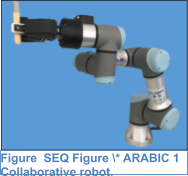COLLABORATIVE ROBOTS DON’T BYTE – BUT ARE THEY “MAN’S BEST FRIEND”?
By Norah O’Shea, John Tobin & Mark Fenelon
In recent times, repetitive lifting and hazardous tasks such as packing / palletising and stock management have been assigned to robots (i.e. pick and place tasks).
These robots are large and require a safety cage to protect operators/workers from straying into their defined path of movement during high-speed operations. An alternative to these conventional robots is a collaborative robot (Cobot), where a safety enclosure is not required and the working space is shared between the Cobot and the worker. Benefits of Cobots include automation of repetitive and precision tasks, freeing up staff to solve problems that require good old-fashioned cognitive processing. Integration of vision and optical sensors into Cobots introduces additional detection/quantification capability, and coupled with machine learning, will eventually lead to decision- making Cobots with more advanced applications in the food industry.

Figure 1
Researchers at Moorepark have already demonstrated the application of a Cobot as part of a methodology for determining reconstitution properties of dairy powders. VistaMilk, through the dairy processing, spoke will build on this by introducing a new Cobot (Figure 1) and a new program of work evaluating the application of a Cobot and integrated sensors to perform lab-based tasks seamlessly. In addition, these modified Cobots have the ability to determine the impact of physical stresses on the organoleptic properties of food, simulating what happens during human interaction.
For more information please contact; Norah O’Shea norah.oshea@teagasc.ie

